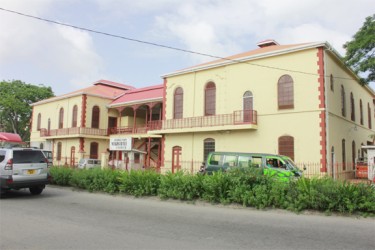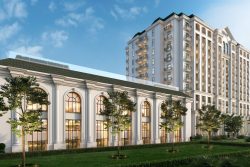The Georgetown Magistrates’ Court will remain housed at the former Globe Trust offices on Middle Street until September to allow additional repairs to its Avenue of the Republic and Brickdam building, according to Legal Affairs Minister Anil Nandlall.
The repairs to the court building have been ongoing for more than two years and in the interim litigants, lawyers, court staff and others have been enduring cramped conditions at the Middle Street complex.
In May 2011, acting Chancellor of the Judiciary Carl Singh, in a public notice, had advised that courts 1, 2, 3, 5, 8 and 9 would be relocated to the Lot 92 Middle Street location, to facilitate the repairs. The notice said court would be conducted at the site until further notice.

Nandlall, in an invited comment, told Stabroek News on Wednesday that the contract was adjusted to have additional works done, including the installation of air conditioning for the entire complex, the construction of two additional courtrooms along with accompanying chambers for the magistrates, washroom facilities and additional parking lots facilities.
“The additional work should be completed by September,” he said when asked about a deadline for the completion of the work.
He said that the repairs come under the project execution unit of the Modernisation of the Justice Improvement Programme, which falls under his ministry.
He added that the first part of the project was done by a project execution unit operating under the supervision of the judiciary. “So any queries about why that aspect of the project was not completed should be directed to the judiciary,” he added.
Since the move, many have complained repeatedly about the cramped conditions and discomfort experienced in the small courtrooms.
Attorney Nigel Hughes, who frequents the location regularly, is calling for the works to be completed quickly. He said that had the “building been built from scratch,” it would have been completed already.
Hughes told Stabroek News that since the relocation “we are suffering from inconvenience.” This inconvenience includes the fact that the building was not built for a court set up. He said that the court accommodation is inadequate for the public and the arrangements in place with respect to prisoners are putting pressure on security officers. He noted that prisoners are in close proximity to the public when being transferred from the holding area to the courtroom.
Hughes pointed out that one can be in a courtroom and hear everything that is going on in the adjoining courtroom.
Attorney Lyndon Amsterdam also said that the building was not built for courtroom purposes. “…You can hear proceedings in other courts because of the type of walls used to separate each courtroom from the other,” he said.
He said too that the inadequate seating accommodation at the court causes a build-up of people on the stairway and the corridors of the court.
Amsterdam also said there is no attorney room for lawyers who may want to have a private conversation with their clients. “So, I am anxiously awaiting the completion and return of the former building,” he said.
Meanwhile, Attorney Mark Waldron said that while he acknowledges that there are several issues with the current location, he realises that he has an obligation to represent his client regardless of the prevailing conditions.
Though this is the case, he said he sees that efforts are being made to remedy the situation with the ongoing renovations at the former location.
“We just have to make the best of it,” he noted.
He said that there is room for improvement at the Middle Street location but acknowledged that it is only a temporary arrangement and expressed optimism that after the long wait, when the court relocates to its original location, “we would have something nice.”





